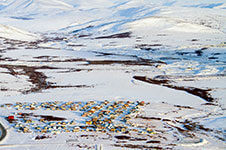When we look at the state of global connectivity, the North American Arctic is one of the most disconnected human-inhabited locations in the world. While there are hundreds of subsea cables in service across the globe, bordering coasts and crossing oceans, the North American Arctic leaves a large gap, that so far, only Quintillion has filled.
When it comes to building subsea cables, the US Arctic poses some very unique challenges. For one, the landscape and environment are extremely harsh and the window to do actual construction work is very limited and unusually difficult. Expansive wetlands, ice structures, complex terrain, and below-freezing temperatures make planning and constructing a cable system VERY challenging to do. The Arctic’s changing environment is making construction somewhat more feasible for the first time in history – prior to Arctic sea ice melting for months in the summer and early fall, laying subsea cables was impossible.
Furthermore, the remoteness of Northern Alaska and the Canadian Arctic make getting materials, heavy equipment, and engineering teams to the Arctic incredibly challenging and very expensive. Crews only have a small window of time to work. When the Arctic ice freezes again come late fall, construction must halt.
Quintillion made the first big step in bridging the digital divide in the US Arctic. By building a subsea fiber optic cable network that borders portions of the north and northwest coasts of Alaska, we became the first and only telecommunication company to bring the gold standard of connectivity (fiber optic infrastructure) to the North American Arctic.
From here, we plan to continue extending our current subsea fiber optic cable system in the US and North American Arctic – building an interconnected global network that connects the European and Asian continents. Doing this will further bridge the digital gap in other parts of Alaska we don’t serve today and support upgrading national security and defense systems in the North American Arctic and beyond.
The Benefits of Building Digital Infrastructure in the North American Arctic
As we dug into the “big picture benefits” of Quintillion’s current Arctic subsea cable route and future phases, we spoke with Quintillion CEO, George Tronsrue III.
According to Tronsrue, one of the primary benefits of Quintillion’s investment to enable communication in the North American Arctic is that no one else has done it to date. “There’s a benefit to being the first. And from a diversity point of view, if we have an Arctic cable, the survivability and redundancy options that provides to the global community are significant.”
An Arctic Cable Provides a Diverse and Redundant Route
By building and connecting a new, diverse Trans-pacific subsea cable route to the existing Quintillion network, the global network only becomes stronger. If a network fails elsewhere, a redundant system means there are backup routes that can transport data to its intended locations. As the first of its kind, Quintillion’s current fiber optic cable infrastructure has delivered high-speed broadband infrastructure to previously unserved areas, while also encouraging redundancy in locations in Alaska where fiber already existed.
While the benefits of a Trans-pacific Arctic fiber optic route are evident, the execution is difficult, time consuming, and expensive – which is why Quintillion’s success in building a system that serves communities in the Alaskan Arctic is so monumental. As mentioned previously, laying cables in the Arctic is expensive and complicated. The techniques used to install a cable in the Arctic are far different than what you’d do in deep water, what you’d do in the Atlantic, and what you’d do across the Pacific. These are multi-year projects that will costs hundreds of millions of dollars to complete.
Alaska’s Strategic Location Enables Interconnectivity
Quintillion is based in Anchorage, Alaska and has deep ties with the Alaska Native communities, local internet providers, and government entities operating in the Alaskan Arctic. There’s no other company in the world that is more strategically positioned and capable of building an Arctic subsea cable system.
Tronsrue explained why Alaska’s position on the globe is so critical. “When you look at the strategic location of Alaska on a map or on a globe, it really is the fulcrum in the Northern hemisphere between Asia, Europe, and North America.” Alaska’s centrality is what will drive future phases of Quintillion’s network.
Quintillion plans to start building a Trans-Pacific Cable System, with a subsea cable extending from Japan to Washington State (JAWS), which will land on Native American land located on the shores of the Olympic Peninsula. The system will connect by Quintillion operated fiber to its Alaska network at existing points of presence (POP’s) in both Seattle, Washington and Hillsboro, Oregon.
Importantly, this establishes a new transpacific network serving Japan and pan Asian markets and offers a diverse, redundant route to the market. As most of today’s trans-pacific subsea routes land in California or Oregon – there hasn’t been a route connecting to Washington State in over 20 years. This work has been underway for several years and Quintillion plans to start the project in early 2023 and complete in 2025 or later, depending on various factors.
The next stage is also in planning and contemplated to start sometime in 2023, based upon government support from US, Canada and Denmark. The intent is to build an Arctic subsea system originating in Alaska with potential landings in Canada, and then extending to Greenland and Iceland, using a low-latency, unique route that further connects the North American Arctic to the rest of the world.
Interconnecting systems from the North American Arctic to both Asia and parts of Europe provides global continuity in communication and broadband capabilities, enabling dual benefits for us and the networks we will connect with.
A Fiber Network Supports the Growing Space Industry
Alaska is also strategically positioned to serve the rapidly growing space industry. Companies launching Earth Observation polar orbiting satellites in space in the next decade, require high-latitude locations from which they can downlink and uplink data. However, most of the world’s high-latitude ground stations are located in other countries that may or may not be strategically aligned with the USA and NATO. Since satellites often carry mission critical or sensitive data, relying on infrastructure in foreign countries can put this data at risk.
At 72 degrees North, the Quintillion HiLDA ground station built in Utqiaġvik, Alaska in January 2021, is the highest-latitude location in the world located on United States soil and is connected to Quintillion’s US-owned and operated fiber infrastructure – providing American civil and military organizations and agencies with a highly secure location to downlink and/or uplink data to or from polar-orbiting satellites. As we continue to build and extend our fiber network, Quintillion can replicate this ground station capability anywhere we have access to Quintillion’s fiber – providing a unique and redundant Arctic ground station as a service (GSaaS) fabric and secure downlinking facility in support of American business and government needs and requirements, as well as those of our American and NATO allies.
An Arctic Cable Network Bolsters National Security
The North American Arctic is already an area of keen interest to the world’s superpowers. Many believe the Arctic is the next global, multi-domain battleground of the future. China, Russia, and other countries aligned with these nations have all displayed posturing tactics in the Arctic, as they attempt to compete with the United States and each other to gain access to the natural resources, rare earth metals, shipping and transportation routes, as well as cyber and defense postures. Russia, in particular, has been militarizing its Arctic frontier for the last 2 decades. The US and Canada have not. To protect the US and North American homeland, especially the Alaskan Arctic, the United States needs to invest now in National Security & Defense upgrades in the Arctic.
Quintillion’s current fiber optic cable network is the only digital infrastructure we have in the North American Arctic. That’s where the North Warning System (NWS) radars are. In the late 1950s, over 40 radars were built through the North American Arctic – eight of which are in the northern regions of Alaska. Geographically, these Alaskan radars are positioned closest to America’s primary adversaries, including Russia, China, and North Korea so they should be the first and highest priority.
This outdated and obsolete warning system has yet to be upgraded to modern technology. Without fiber in the Arctic, upgrading these systems on the Alaskan coast from analog to digital infrastructure was not possible. However, with Quintillion’s fiber network, it’s now feasible to modernize and upgrade these radars to ensure that they have the capability to adequately warn and prepare the United States and its NORAD/NORTHCOM partner, Canada, against the current all domain threats to this region and the Homeland.
Quintillion is making progress connecting these old radar sites to our fiber optic cable system, with the immediate goal of providing higher speed, more throughput, lower latency and higher reliability transport of the data to those who need it. More importantly, this is laying the foundation for digital infrastructure in those locations so the update and/or replacement of these radars is now feasible. We are able to support modern ground based and sea-based warning systems in Alaska and are willing to do whatever is necessary. At this point in time, Quintillion alone can do this in support such national security and national defense initiatives.
The Road Ahead: Further Developing Our Arctic Cable Route
Quintillion’s current fiber optic cable system has provided many benefits for the Alaska community and the nation. By providing a middle-mile network in the Alaska Arctic, tens of thousands of Alaskans now have options for access to high-speed broadband provided by local internet service providers who use Quintillion’s fiber infrastructure. This system also supports national security measures, now and in the future, and enabled the highest -latitude satellite ground station on American soil.
As we plan to further develop and extend this system, our goal is to continue bridging the digital gap in Alaska, supporting the US military in the Arctic, and achieving global interconnectivity. The Arctic is a difficult environment to work in, but overcoming the hurdles is well worth the risks and challenges, if not a strategic necessity for our country as a whole.
Quintillion is spearheading the movement in connecting the North American Arctic to the rest of the world. Contact our team to learn more.

















